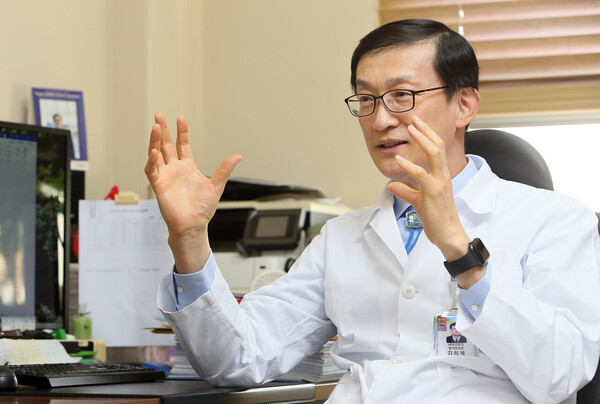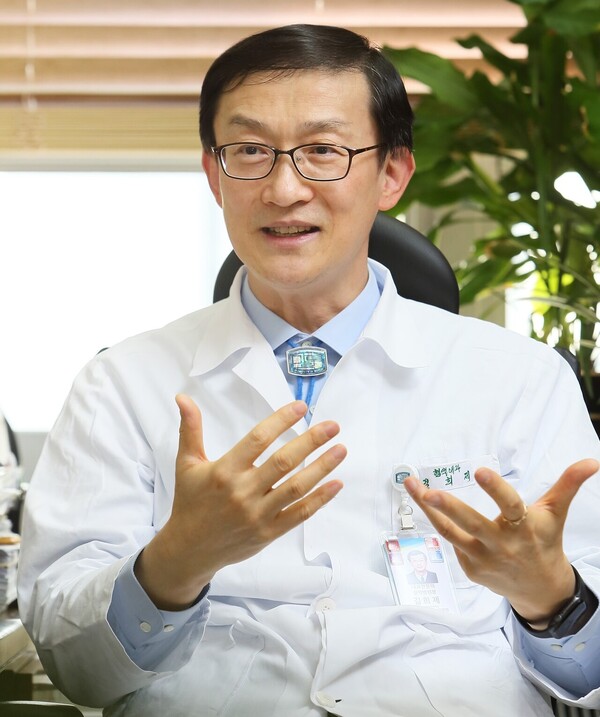'Treatment option needed to reduce steroid’s side effects and control symptoms’
Graft-versus-Host Disease (GvHD) happens when particular types of white blood cells (T cells) in the donated stem cells or bone marrow attack the patient’s body cells. It happens because the donated cells (the graft) see the patient’s body cells (the host) as foreign and attack them.
Usually, steroids are used first for GvHD treatment. However, this leads to a variety of side effects, and a significant number of patients fail steroid treatment. In this case, there is no established standard treatment.
In May, Jakabi (ruxolitinib) won approval from the Ministry of Food and Drug Safety to “treat patients aged 12 and older with acute or chronic GvHD who did not show sufficient responses to previous corticosteroid treatment.
Jakabi has large unmet demands among Korean patients, as shown by nearly 100 approvals for its use for treatment purposes before authorization. However, it has yet to receive insurance benefits despite the formal approval, requiring improved treatment access.
Against this backdrop, Korea Biomedical Review met with Professor Kim Hee-je of the Hematology Department at the Catholic University of Korea Seoul St. Mary Hospital, also chairman of the Korean Society for Blood and Marrow Transplantation, to hear about the domestic situation, treatment strategy, and unfulfilled needs regarding GvHD and the clinical value of Jakabi in treating GvHD.

Question: The disease has quite an unfamiliar name. What is GvHD?
Answer: Besides disease, GvHD has various suffixes, such as reaction and phenomena. Their nuance may change little by little depending on the nature of the immune response caused by allogeneic hematopoietic stem cell transplantation. This immune response can be helpful or harmful to the patient, so it is described as a "double-edged sword." GvHD, which appears after transplantation, cannot be entirely seen as the effect of the donor's cells. Immunologically triggered parts of the patient's body also play an important role. Subtle residual immune cells or chemicals from cells in the patient's body trigger an immune response.
Q: We wonder if there are any differences between races and countries in the outbreak of GvHD. What is the current situation in Korea?
A: The frequency of GvHD outbreaks differs by country. Academic papers published in Asia believe there are basic genetic differences between America, Europe, and Asia. Even with the same treatment, the pattern, height, and frequency of immunological reactions all come out differently. There are also quite many data that demonstrate these genetic differences. To put it bluntly, even if transplantation is performed similarly, the incidence of GvHD in Asians is about 10 to 20 percent fewer than in Westerners. This seems to be due to the basic antigenic system that triggers a major immune response. The human leukocyte antigen (HLA) is an antigen. There is a difference that the Asian system is simpler.
The source of allogeneic transplants is four – parents-children, brothers, strangers, and cord blood. Regardless of any of these settings, Westerners have an acute or chronic incidence of GvHD of about 70 percent. On the other hand, we see the chance as 25-30 percent in Korea. Recently, transplants have been activated, and gene discrepancies occur little by little between parents and children and cord blood, changing the frequency pattern. Compared to the past, it has doubled since the 1990s. In other words, the incidence rate of 25-30 percent has recently increased to about 50-60 percent. It still is about 10-20 percentage points lower than Westerners, but the frequency of occurrence in Korea is not small.
Q: What are the symptoms of GvHD in patients with homogeneous hematopoietic stem cell transplantation?
A: Generally, GvHD is acute or chronic, depending on the time of occurrence (around 100 days). It is also classified into mild, moderate, and severe, according to the severity. When moderate-severe GvHD occurs, patients die within three to four months in acute cases. It usually occurs in the skin, intestines, liver, and other organs. If acute and chronic overlap, symptoms appear in all organs with mucous membranes. The problem is that most of our organs have mucous membranes. Therefore, from the lungs and neurogenesis to the digestive organs, which are major target organs, and from the liver to the skin with a wide surface area will come under attack.
GvHD should be controlled in a short period because of uncontrollable symptoms, but there is no clear answer despite research conducted over the past decades,
Q: How do you treat GvHD currently?
A: Allogeneic hematopoietic stem cell transplantation has been carried out worldwide for the past 50-60 years. Korea also succeeded for the first time in 1983 at St. Mary's Hospital, marking 40 years this year. So it has a long history, but GvHD treatment that occurs after transplantation has been at a standstill with little progress in the last half-century. Currently, a drug called "corticosteroid" is used as the primary treatment for chronic and acute GvHD. Because GvHD is an immune response, donor cells operate primarily, and we must suppress B cells or T cells. Corticosteroid is the cheapest and most effective drug for this.
Of course, not all GvHD patients require treatment. Some do not show GvHD symptoms, and 40 percent are mild patients. The problem occurs when they show moderate or severe symptoms. In only 25 percent of such patients, immune responses completely disappear within days of using a corticosteroid. Others who do not respond to corticosteroids in the first place are “dependency patients” who respond but require continuous use or are “resistance patients” who do not respond anymore. Resistance patients require three-five years or 10-20 years of treatment while increasing and reducing doses.
Patients who receive treatment for three years or more experience weakening of organs and immune functions and die due to infections, such as blood poisoning. Patients with moderate or higher chronic GvHD for more than three years have a three-to-five-year survival rate of less than 20 percent. Besides, there are numerous complications resulting from the prolonged use of immunosuppressants. One of them is secondary cancer because their cancer prevalence is 20 times higher than ordinary people.
Drugs containing steroids are inexpensive, but countless side effects are written on their caution columns. In addition to secondary cancer, infectious diseases, organ failure, bone necrosis, diabetes, hypothyroidism, and sexually transmitted diseases are typical. In particular, if GvHD is above the moderate level, patients must take a very large amount of medicine for a long time. In this case, side effects, such as hip necrosis, occur in about 15 percent of patients requiring artificial joint surgery. As the primary treatment has these serious side effects, overcoming them is the task given to us.

Q: If so, how does follow-up treatment proceed in patients who can no longer receive steroid treatment?
A: There are no optimal drugs for secondary treatment. In the case of chronic GvHP patients who take 10-20 years of treatment, oral treatments are preferred. It is relieving in this regard that some pills have been developed recently.
One of them is Jakabi. The drug received the spotlight in the academic community through both phase 3 clinical trials on acute GvHD patients, the REACH2 study, and those on chronic patients, the REACH3 study. Notably, in the case of chronic GvHD, responses to treatments have varied widely, making it difficult to attain good results over the past half-century. Jakabi’s positive results in the two studies were significant in that regard.
When we used Jakabi in the real world, a quarter of one-third of patients who had not responded to any treatments before showed some response. In other words, steroid-dependent or steroid-resistant patients showed improved symptoms, though varying by organ, and restored their functions.
The problem is that Jakabi still needs insurance benefits, and patients should spend about 3 million won ($2,400) monthly. For patients who must take it for several years, the burden could increase to millions of won. Therefore, we recommend its use to younger patients in their 20s and 30s.
Q: What are its treatment outlooks?
A: Among patients with chronic GvHD fixation, 80-90 percent still show no response to treatment. This is the blind spot and limitation of the hematopoietic stem cell transplantation field. However, transplantation is still an inevitable path. Unless a better treatment is developed, homeostatic hematopoietic stem cell transplantation is the best and last treatment. Various efforts have been made to minimize the inevitable complications after transplantation. Recently, Jakabi and other drugs have shown some effects in patients who have not responded to treatments. Better drugs are coming up, and many efforts are being made to improve the transplant method. Therefore, I expect these efforts to bring about better treatment results together.

